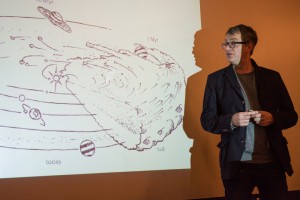A great mingling experience
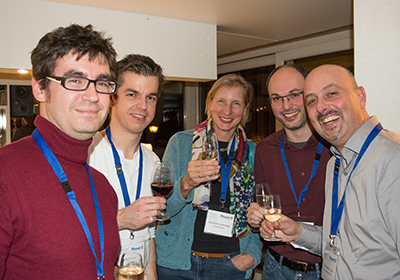
At the first General Assembly of the NCCR PlanetS, 93 participants gathered in Anzère (VS) at the end of January 2015 to present their projects, discuss their goals and get to know each other.
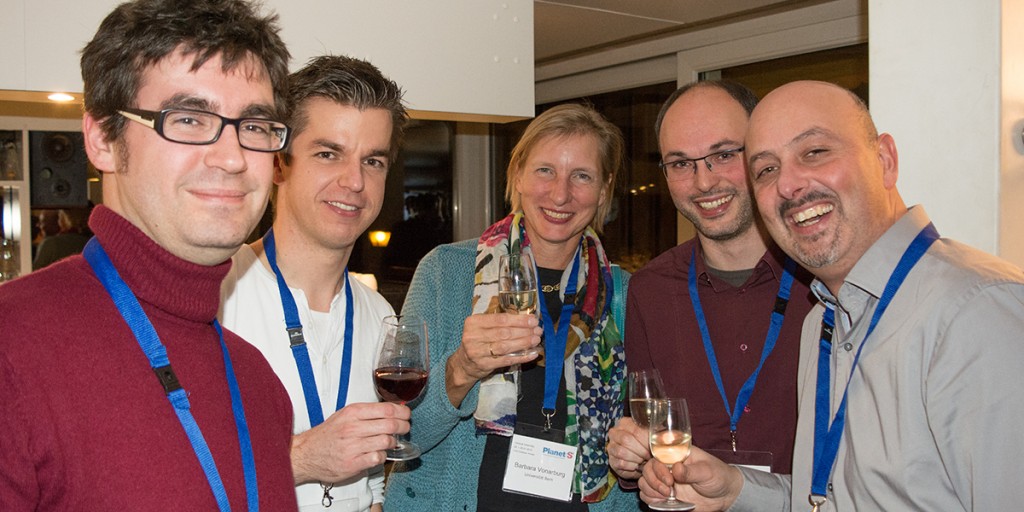
Good mood at the first general assembly of the NCCR PlanetS (from left): David Ehrenreich, UGE, Sascha Quanz, ETHZ, Barbara Vonarburg, UBE, Christophe Lovis and Francesco Pepe, UGE. (Credit: G. Schwarz)
«They do know how to pick a meeting location,» twittered Brian Schmidt adding a nice photo of Anzère with snowy mountains. The winner of the Nobel Prize in physics 2011 is a member of the advisory board of PlanetS and had attended the World Economic Forum in Davos before he travelled to the Valais. The astrophysicist of the Australian National University in Canberra was joined by advisory board member Michel Mayor who came back from Borneo just in time to listen to the presentations of the PlanetS scientists. «Our advisory board was very attentive,» says NCCR director Willy Benz: «Brian and Michel have an enormous experience in dealing with complicated research projects. Therefore I am very happy about their positive feedback.»
During three days the participants of the general assembly informed their colleagues about the structure of the complex research program, the on-going work and future projects. Five platforms and seven research projects had to be introduced and explained. Equipped with 3-D glasses the participants enjoyed the fantastic images of an avalanche on Mars presented by Nicolas Thomas, leader of the project «Solar system remote sensing». «At first glance it looks like a dead landscape – it’s not,» Nicolas Thomas explained: «The surface is actually very dynamic.» Analysis of data taken by the instruments HiRISE and CRISM on board NASA’s Mars Reconnaissance Orbiter revealed that these events are similar to terrestrial powder avalanches and falls of loose, dry snow.
New ideas and collaborations
«I was not only impressed by the team’s 3-D technology but also by its large know-how in satellite technology, image processing, laboratory work and chemistry,» says Francesco Pepe, leader of the project «Planetary Atmospheres». As stunning as the Mars pictures was a 3-D video of comet 67P/Churyumov-Gerasimenko generated from images taken with the Rosetta’s OSIRIS camera instrument showing large-scale dust activity. For Ben Moore, leader of the project «Numerical Laboratories», the presentation of Nicolas Thomas was a special highlight. «During his talk I came up with a new idea for the origin of this comet, which my graduate student Volker Hoffmann is now testing via numerical simulations,» says Ben Moore. He even had time to make a video at the conference and post it on YouTube.
The most important item on the program was officially called «Interaction between projects» or as Willy Benz put it: «Time to mingle!» He urged the participants to not go back to their rooms and read a book but to talk to each other – what almost everybody did. «It was very stimulating to interact with all the members of the different projects,» says Michael R. Meyer, leader of the project «Disks and Planets». As many of the participants he suffered from a cold but nevertheless enjoyed the general assembly very much: «I do not recall a time before in my life when I had so many things to say (because of the fascinating work of so many colleagues), and less of an ability to say them (because of illness),» summarizes Michael R. Meyer. And Francesco Pepe from the University of Geneva adds: «When I was talking to the people of the ETH Zurich we generated a lot of new ideas for collaborations and we have already started to realize them.»
To mingle was the keyword for the successful general assembly according to Francesco Pepe: «Different people coming from separate places sitting together in a well-organized but spontaneous environment – that is crucial for creating new ideas.» The pleasant and friendly atmosphere helped PhD students, postdocs and professors to get in touch with each other. At dinner, the NCCR director himself ensured with the help of a tricky task that everybody was mingling. «Willy gets bonus points for organizing a fun and informative game,» says Michael R. Meyer. Everybody had to draw a raffle ticket, find partners and figure out as a team what the numbers and letters were standing for – a special planet, of course. «First I thought it was a bit awkward to play a game,» says Andrea Fortier, CHEOPS Instrument Scientist. «But to my surprise it worked really well – and it was fun.» The fun was only topped the next night when two groups of participants from Geneva and Bern sang at a Karaoke bar in Anzère. «We got a strong feeling of solidarity,» remembers Yesim Ege Vogel from the NCCR programme office.
Discussions at the breakfast table
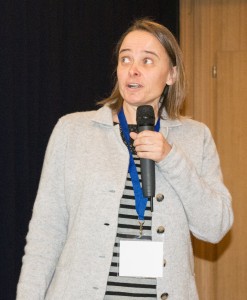
Maria Schönbächler is responsible for the advancement of women within the NCCR PlanetS. (Credit: G. Schwarz)
Almost a third of the participants in Anzère were women. To form a network and talk about gender issues in science, a women’s breakfast was organized. «The discussion was very lively and interesting,» says Maria Schönbächler who is responsible for the advancement of women within the NCCR PlanetS. The attending young female researchers generally agreed that gender equity concerns both men and woman and many of them felt that so far they have not been at a disadvantage because they were women. Some went even further and proposed that gender equity should not privilege women: «If I got a job just because I were a women, I wouldn’t accept it,» said Heather Cegla, postdoc at the University of Geneva. Despite these statements most of the young researchers were sceptical whether they could successfully balance raising children with a conventional academic career. Having to work full time (or even longer hours) and spend long periods abroad to be competitive does not allow for a traditional family life.
«There are part time jobs, but it seems that many participants are not aware of them,» says Maria Schönbächler. She wants to ensure that the young researchers will get the information about interesting opportunities such as the «120% support grant» of the Swiss National Science Foundation. This grant allows postdoctoral researchers to reduce their work-time percentage and hire a support person for the same period. «You have to apply for it,» says Maria Schönbächler. Like other female researchers at the breakfast table in Anzère she didn’t feel that gender discrimination had impeded her career, but realized that this is still an urgent issue when she was appointed to ETH Zurich, where women occupy only 12 % of the professorships. «In higher positions there are still far to few women and this is partly due to unconscious biases we all have,» says the professor at the ETH Department of Earth Sciences.
A noble advice
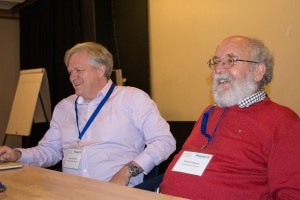
Brian Schmidt and Michel Mayor impressed the participants of the general assembly with their accurate remarks. (Credit: G. Schwarz)
To improve the situation both men and women should be included in equal opportunity events, some of the young female researchers suggested. The discussion about enhancing the career opportunities of women continued in the final event at Anzère, when Brian Schmidt summarized his first impressions of the NCCR PlanetS. He suggested that the Swiss potentially could learn from efforts made in Australia within a collaboration called CAASTRO, comparable to PlanetS. The Nobel Prize winner is chief investigator of CAASTRO and chairs a gender committee that tries to help to «improve the prospects for women to navigate the leaky pipeline between PhD and tenured researcher».
With their accurate remarks Brian Schmidt and Michel Mayor impressed the participants of the general assembly. «Now we try to implement their suggestions,» says Willy Benz who thinks that the first big conference was very helpful in reaching his goal: «We want to build a team,» says the director of PlanetS. «Therefore people have to know each other and be informed what is going on.» He is convinced that the meeting in Anzère gave a good kick to form a team spirit. «But this is like a soufflé, we have to be very careful in order that it does not collapse.»
Pictures from General Assembly Anzère
View the complete picture gallery here.
Categories: Internal Newsletter
